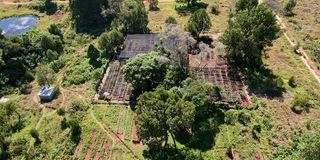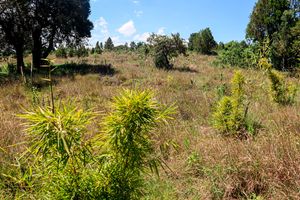
An aerial view of the Kaptagat Forest bamboo demonstration site on October 11, 2024.
Months before Environment Cabinet Secretary Aden Duale publicly announced the disbandment of the Kenya Water Towers Agency (KWTA) on December 14, 2024, a series of letters exposed how the stage was being set to make the controversial move.
One letter was from the Public Service Commission (PSC) to Environment Principal Secretary Festus Ng’eno highlighting two written complaints from KWTA staff dated August 13 and 22, 2024.
“In the complaint, it is alleged that KWTA was unprocedurally dissolved and that they have been unduly disadvantaged exponentially, that they doubt all the legal requirements were followed for the dissolution of KWTA and that the State Corporations Advisory Committee and the Attorney-General did not advise on the same,” the PSC letter read in part.
In the meantime, audit questions on how Sh147.7 million was spent on a “ghost” bamboo project in Kaptagat Forest continued to haunt KWTA. In response to Auditor-General Nancy Gathungu, KWTA’s management stated that the audit did not fully consider all the activities at the site.
It indicated that the site serves as a source of bamboo seedlings for several other projects, including the Cherenganyi Hills Water Towers, Ewaso Nyiro South, Mt Kenya and the Aberdares. Additionally, the site was being used to implement the Lake Victoria Environment Management Project.
This response, according to Ms Gathungu, did not adequately address the concerns raised and did not justify the lack of activity at the demonstration centre itself, therefore highlighting potential mismanagement of funds and the failure of the bamboo project to achieve its intended objectives.

The remains of a school at Sierra Leone area in Mau Forest on October 13, 2024.
Beyond the bamboo project, yet another red flag the Ms Gathungu raised was KWTA’s inability to produce or at least cite any title deed belonging to it. The agency had on multiple occasions stated that it had recovered encroached water towers, but there was no evidence of title deeds to secure these areas. This, says former KWTA chairman Isaac Kalua, has a long history.
“We even got funding from a UN agency for titling every water tower wherever it was,” he says, recalling his time at the agency.
The idea was that these were national assets and they would be secured at the National Treasury “so that no one can ever access the documents for the purpose of excising”.
But the environmentalist recalls going to meet a senior Ministry of Lands official at the time over the title deeds and was shocked by what he was told.
“She said, ‘Isaac you are my friend, but do you want me to lose my job for issuing titles to water towers?’ I knew we were dealing with a bigger problem,” he says.
But even before the report by the Auditor-General, the scandal that is the Sh147.7 million spent on the National Bamboo Demonstration Site seemed to have been an open secret within the agency.
On June 22, 2023, members of the board of KWTA visited the site to confirm that what the management was telling them about the project’s status on the ground was true. The board was by then led by former CS Rashid Echesa. They were accompanied by the CEO Julius Tanui.
After their visit and return to Nairobi, presumably shocked by what they saw on the ground, the board resolved to send the CEO on compulsory leave so as to investigate the project.
But what followed shocked many at the agency: the Environment ministry overturned the decision and reinstated Prof Tanui, stating that the matter could be resolved using alternative means.
But even before this was resolved, board members who had asked for the investigation were removed within two months, and new ones installed.
On November 16, 2023, Dr Nge’no, through a letter, appointed former Coast Regional Commissioner John Elungata to the board as the ministry’s representative. He replaced Ms Miriam Karanja.
About eight days later, on November 23, 2023, Energy PS Alex Wachira also replaced board member John Muiruri with Mr Dan Kithinji Marangu as his representative.

Women carry firewood outside the fenced Kaptagat Forest bamboo site in Elgeyo-Marakwet County on October 10, 2024.
Four days later, on November 27, 2023, Mr John Orumoi was appointed to the board, replacing yet another member, this time representing the PS in the National Treasury Chris Kiptoo. These replacements raised eyebrows as they coincided with the Ethics and Anti-Corruption Commission (EACC) investigations and the unresolved accountability questions.
On November 10, 2023, just a few days before the board replacements, the EACC had sent its first letter to the agency, seeking to find out more details about the bamboo site.
It was only responded to close to a month later, through a letter dated December 4, 2023, days after the majority of the board members had been replaced. It is within this new board that sources familiar with the affairs of the agency, but who spoke in confidence, say the idea to dissolve it was floated.
But there was a problem: an agency of this nature could not just be dissolved by the stroke of a pen. The disbandment would at least require a Cabinet ratification first.
So, the board went back to Legal Notice 27 of 2012 that established the Kenya Water Towers Agency and section 21 of the Statutory Instruments Act that called for its dissolution after 10 years of operation.
Section 21 is eventually what was used to shut down the agency, despite the fact that this part of the Statutory Instruments Act had been abolished by the Finance Act of 2023 and that the Act is in fact still operational on the strength of an order by the Supreme Court.
On May 24, 2024, the Environment ministry seconded Prof Tanui, the agency’s CEO, for nomination to serve in the African Union’s Sustainable Environment and Blue Economy Directorate. Through a letter to his counterpart in the State Department of Foreign Affairs Korir Sing’oei, Dr Ng’eno seconded Prof Tanui to the position of Environment Specialist, Circular Economy and Pollution.
PSC wrote to Mr Duale, in a letter copied to Dr Sing’oei, stating that the redeployment of Prof Tanui to the AU was done without its approval and was, therefore, unlawful.
“Without the approval of PSC, the staff of the agency are being seconded and/or deployed to various public service institutions and ministries,” PSC wrote.
The commission further urged the Environment ministry to provide clarity on the matter.
“Provide all necessary information/material/approvals relating to the dissolution of KWTA,” PSC said.
The AG, in a letter to Mr Duale, noted that Dr Ng’eno had written in response indicating that no staff had been redeployed.
However, when the Nation visited KWTA to establish whether staff had been redeployed, we learnt that eight of them had been moved back to the Environment ministry headquarters. Mr Duale said that the affected staff “are extremely happy”.
The statement by Mr Duale raises the question why the “happy” employees would be the same ones writing protest letters about the dissolution of the agency and their controversial redeployment.
Prof Tanui’s redeployment happened less than a month after a heated session in Mombasa before the National Assembly’s Environment committee led by Nakuru Town East MP David Gikaria, where both Dr Ng’eno and Prof Tanui were present. They were at pains to explain the expenditure on the bamboo demonstration site.
The committee session was immediately followed by an unexplained withdrawal of Sh8.88 million from the agency’s account at Kenya Commercial Bank’s Capitol Hill branch. Some Sh2.08 million of these withdrawals were indicated to have been used for “engagement with members of National Assembly” and were handled by two KWTA employees.
While it was not clear what the “engagement” involved, Mr Echesa, the board chairperson, believed that these monies were meant to bribe the lawmakers to look the other way and even wrote to EACC to investigate the circumstances around the withdrawals.
On August 14, 2024, just two days after Mr Duale took over the Ministry of Environment from his predecessor, Ms Soipan Tuya, he embarked on one of his initial orders of business. Convinced by an advisory and a visit from key members of the board, Mr Duale wrote a letter stating that KWTA had ceased to exist.
However, days later, Mr Echesa sent a letter to Mr Duale challenging the directive and citing the solid legal standing of the agency. This position was later confirmed by AG Dorcas Oduor, who advised against dissolving the organisation.
Head of Public Service Felix Koskei, caught up in the chain of letters regarding the dissolution of the agency, also referred the dissenting factions to the AG.
In even more curious developments, the Nation has established that some vehicles belonging to the agency were already deployed for the use by a senior Environment ministry official and his representatives.
Dr Ng’eno and Prof Tanui, are yet to respond to a series of questions we sent to them in October 2024 on the Environment ministry and the agency. We first reached out to the PS’s known communication official with specific questions he was to answer.
“I shared the questions with him, PS Ngeno was out the whole day yesterday, once I see him I will ask because he is in a meeting now,” the aide responded in a mobile phone text message on October 15, 2024. A week earlier, she had told us that the PS was in Baku, Azerbaijan, for meetings ahead of COP29 and would not answer our questions.
Subsequent communication in weeks that followed was not responded to. Prof Tanui, just like the PS, did not also immediately respond to our questions.
“We are not in Water, maybe talk to someone in Water (ministry),” he responded in a text message to our specific questions on his tenure at KWTA. When our reporter called his known number to clarify what he meant, he said: “Contact the communications manager at KFS (Kenya Forest Service). KWTA is now under KFS.”
We also wrote letters to their two offices on November 12, 2024 with questions we wanted answered for this article. The letters were stamped as received at both offices on November 15, 2024, but they have not been responded to since then, despite reminders.
Further, we reached out to Mr Echesa, but he did not immediately respond to our enquiries. He has since been moved from the agency and now chairs the National Council for Occupational Safety and Health, an appointment made towards the end of November 2024.
As we waited for responses about what was by then a plan to dissolve KWTA, the agency was ultimately dissolved and an announcement made by the Environment ministry on December 14, 2024.
“In November 2024, in two separate Gazette notices, the board of the KWTA was dissolved and members taken to other agencies. The chairman was also removed and taken to another agency, so what do you do with an entity which doesn’t have a board, and has no sound legal standing?” Mr Duale asked, adding that he saw no problem being the first to implement the Cabinet decision on merging and disbanding some parastatals or agencies. His contention is that KWTA’s legal status had expired and it was also duplicating the role of KFS and the National Environment Management Authority.
About the accountability concerns raised by the Auditor-General and being investigated by EACC, Mr Duale said: “Investigations will continue, you can even be arrested after 20 years. EACC will continue with the investigation into the Sh147 million and I’ll even write to them that the investigation must continue.”
However, Mr Kalua, says disbanding the institution goes against President William Ruto’s administration’s stated commitment to the environment.
“I believe that this is not the right thing. The success of any president is ensuring that the natural capital we have is preserved for posterity,” he says.
Mr Kalua believes there could be a plot to allocate some water towers to individuals “and that is why none has been properly fenced and none has a title deed”.
Meanwhile, things appear to be drastically changing at some of the country’s critical water towers.
In the Mau, for instance, perhaps to take advantage of the gap, political leaders are re-igniting the conversation of occupation of the forest by persons who had initially been evicted. The Nation also observed that the fence that KWTA put up in 2019 to protect Kaptagat Forest from encroachment is porous and there are signs of human activity inside the forests. Beer and whisky bottles as well as plastics are being dumped in the area.
At the moment, KFS appears to have taken over the site with four nursery beds, each with hundreds of seedlings.
“Another issue is that the few bamboo seedlings that KWTA officials attempted to plant here in 2019 could not withstand the climatic conditions of this area and so they died almost instantly. We have now sourced bamboo seedlings that can do well here,” said a KFS official we found at the site, speaking on condition of anonymity as he is not authorised to comment on behalf of the service.
He showed us the one acre of land where the dead bamboo seed beds sat. They have been overrun by tall grass and bushes.
Mr Kalua still hopes the agency can be revived.
“The abrupt move to dismantle KWTA, an organisation I once had the honour of chairing, threatens to unravel decades of environmental progress, and exposes our natural resources to renewed threats of degradation and mismanagement.
“I make a fervent appeal to the President, through the conscientious oversight of the minister, to reverse this hasty dissolution. When we started, the country had only five water towers but by the time I was leaving we had identified about 140 and now they are about 180,” he says.









